 Saint Elsewhere...?
Saint Elsewhere...? Saint Elsewhere...?
Saint Elsewhere...? Discovery of
St Faith's, Newton in the Willows, Northamptonshire - a
church with a dark history, now an activity centre (January
1st, 2014). Read the story here
Discovery of
St Faith's, Newton in the Willows, Northamptonshire - a
church with a dark history, now an activity centre (January
1st, 2014). Read the story hereThere is, of course, the French shrine at Conques, which you
can read about on the 'Saint Faith' page (follow this link).
Below are features on some of the churches and places which we
have discovered: new discoveries are flagged up at the top of
this page and added towards the bottom. Finally, in THE
DIRECTORY, you can see the expanding list of all the
dedications of which we are aware. The current, very
provisional, total of churches past and present and other
buildings associated with St Faith's name is 61 (plus a ship, a
crematorium, a rare token... and even a garage and a pub)
Saint Faith by any other
name
 June 12th, 2009.
An entry giving the purported story of Saint
Faith, in an 1866 document sent to us by Mrs Mary
Rae, descendant of our founder, Douglas Horsfall,
mentions a dedication 'in the names of Saint Faith
and All Saints, in Little Wittenham. Berks.' Upon
investigation, the church in that place is
dedicated to St Peter, but a footnote to one web
page mentioning the place does indeed refer to the
quoted dedication. Pending further enlightenment,
the church has been added provisionally to the
foot of the list of
English churches dedicated to 'our saint'.
June 12th, 2009.
An entry giving the purported story of Saint
Faith, in an 1866 document sent to us by Mrs Mary
Rae, descendant of our founder, Douglas Horsfall,
mentions a dedication 'in the names of Saint Faith
and All Saints, in Little Wittenham. Berks.' Upon
investigation, the church in that place is
dedicated to St Peter, but a footnote to one web
page mentioning the place does indeed refer to the
quoted dedication. Pending further enlightenment,
the church has been added provisionally to the
foot of the list of
English churches dedicated to 'our saint'.
The Maori Saint Faith's
The photographs are of a New
Zealand St Faith`s. This is at Ohinemutu, Rotorua, and is shared
by Maori and Pakeha people in worship.
The lakeside building is adorned with a distinctive window
showing Christ walking on the water.
April 15th, 2009: three new pictures of
the church brought back from a visit by Mrs Joan Utley
November 13th, 2008: A
fully illustrated feature on the church, based on its
guidebook, can be seen HERE
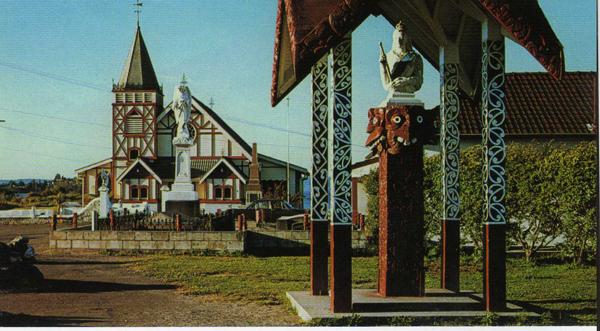 St Faith's with the statue of Queen Victoria |
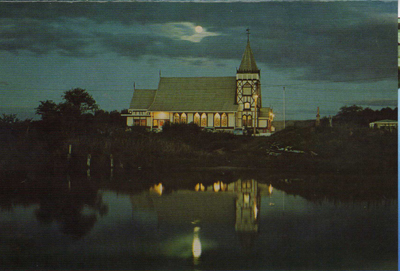 St Faith's by moonlight |
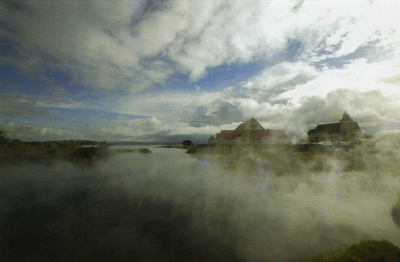 St Faith's across the lake: early morning |
|
|
Saint Faith in the Golden Valley: Dorstone, HerefordshireTraditionally it is stated that
Richard de Brito, one of the murderers of Thomas a Becket
founded a chapel in the neighbourhood of this church in
expiation of his crime. Stones found at the site of the
church during two of its rebuildings indicate a date of
1256 and it is considered that the original church on the
site was founded by Johannes de Brito who died in 1275.
There is, however, a belief that a church existed on the
site before the Norman conquest and that Richard de Brito
added a chapel to it. The church was dedicated to the
Virgin Mary. During one of the rebuildings a tomb, thought
to be that of Johannes de Brito, was accidentally broken
into and accompanying the bones of a tall man were an
ancient pewter Chalice and Paten together with fragments
of silver thread.
The
ancient church was taken down in 1827 and a poor
structure, in the old church warden style, was
substituted, this new church being dedicated to Saint
Faith. This church was removed some 50 years later and a
new one erected in 1889, the new building being designed
by Messrs. Nicholson & Son of Hereford as nearly as
possible on the lines of the old church. Some items were
retained including the four bells, three from the 17th
century and one from the 16th. The present church
consists of a Chancel, nave, South Porch and a Western
Tower which retains the 13th century tower arch.
Examples of the old church have been preserved and
inserted in the Chancel.
It is believed that behind the date stone in the east
wall of the church is a glass bottle containing one of each
of the coins in circulation in 1889. Below the foundation
stone of our church there is also a glass bottle containing
coins in circulation during 1898, the year the foundation
stone was laid. Another interesting point is that the two
churches have associations with Archbishops of Canterbury.
St Faith`s, Dorstone appears to have originated due to the
murder of an Archbishop of Canterbury, Thomas a Becket,
whilst Robert Runcie is an "old boy" of St Faith`s, Crosby.
 Rare
bats’ roost discovered in Dorstone Rare
bats’ roost discovered in DorstoneBats in the belfry are not unusual in our churches, but St. Faith’s at Dorstone is home to not just one, but two of the rarest species in Europe. Conservation officers at Natural England have been alerted to the presence there of Barbastelle and Lesser Horseshoe bats. The discovery was made by ecologist Eric Palmer who has been radio-tracking Barbastelles in the Golden Valley and tracked one to St. Faith’s. He said the bats had chosen a well-appointed roost. He hoped their presence was not causing concern to the parishioners at Dorstone. They knew they had bats but were unaware how special their guests were. “We were thrilled that these two bats have been identified as in our church,” Ray Birchenough, a local naturalist and member of the congregation said. The Rector, Roger James, added, “I had no idea we were sheltering such an illustrious animal. I have only heard grumbles about the mess bats can cause.” (with thanks to Peter Stokes: update added February 25th, 2008) |
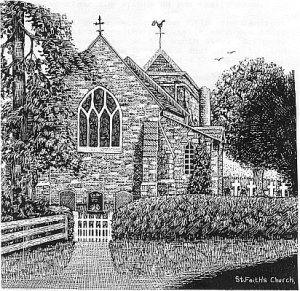 |
|
One of the car/passenger ferries
operated by WightLink between Portsmouth and Fishbourne on
the Isle of Wight is called St Faith. This 2968
ton ferry was built in Selby, Yorkshire in 1990 and is
named after the church of St Faith in Cowes, Isle of
Wight. The ship can carry 1000 passengers and 142 cars;
her service speed is 12.5 knots. Sister ships on the same
route are St Catherine, named after the point of
land on the Isle of Wight, St Helen, named after a
village in the east of the island, and St Cecilia,
named after the nunnery at Ryde. The names were given by
the then operators, Sealink. A new addition to the fleet
is the St Clair.
September 2004 update (thanks to David Fairclough). During the D- Day celebrations on June 5th this year, the “St Faith” was the only passenger ship cruising off the Bar Channel at Southsea and around the Solent, carrying many veterans to watch the departure of the naval convoy to France for the weekend commemorations. Her passengers were issued with 1940s style ration
books in order to obtain breakfast and a drink onboard.
It wasn’t the first time the ship had been charted by
the veterans: she was used in 1994 for the D-Day review
cruise.
|
The Rev'd Paula Porter Leggett, Rector of our namesake church in Canada, has told us about her Saint Faith's.
'The Christian Community of St. Faith is an Anglican congregation of the Diocese of New Westminster, in Vancouver, British Columbia, Canada. The parish was founded in the post-war boom in September of 1947, and used a one-room building for worship, banquets and even badminton. The present church building was built in 1955, with the first worship being held on Easter Sunday. The mortgage on that building was "burned" in 1969, at which time the building was consecrated.
We tell the story of St. Faith every year now on the Sunday closest to October 6th, but from my reading I believe the primary reason the church was named for St. Faith was to make a connection to the Church of England, particularly St. Paul's Cathedral where the remains of an ancient church dedicated to St. Faith exist, as well as a connection to the chapel of Westminster Abbey. Today the church is thoroughly 'Canadian,' seeking to include people of all ages, cultures and abilities. The last historical commentary written about the parish (1997) remarks that the parish has always 'been in the forefront of Anglican church renewal' and that 'from the outset the focus of the parish has been to "equip the saints for ministry".' Liturgical flexibility and creativity with continuity continue to be nurtured here. While changes in the neighbourhood and world have reduced the size of the congregation substantially, equipping the saints at all ages and stages of life, and taking the love of Christ into the world in practical and compassionate ways continue to characterize this community of St. Faith.' '
(See below for an older St Faith's presence in Canada)
Saint
Faith
in Australia
St Faith’s, Montmorency, Melbourne
Parishioner Barbara Talbot writes below about her Australian
Saint Faith’s.
Montmorency is a hilly, treed suburb some 15 kms north of Melbourne. It was originally built as a church primary day school at the instigation of the daughter of Bishop Arthur Green. It was opened in 1918, attached at first to the Parish of Diamond Creek with Greensborough, then became a parish in its own right in 1962.
The building was designed as a school with a recess which could be curtained off as a sanctuary for occasional church services. When the school was closed in 1921 the building became exclusively used as a church. Since the 1950s the site has been built up and the building expanded, and now has a hall, a kindergarten and various ancillary rooms.
In terms of churchmanship, St Faith’s Montmorency is ‘middle of
the road’, with candles and vestments. The Patronal Festival is
celebrated, and the main Sunday service is a Family Sung
Eucharist. As with so many churches, there are very few younger
people in the church these days. The parish priest is Scott
Bramley, and Barbara Talbot is happy to be contacted at barbtalb@techinfo.com.au
Countdown to
Closure
On
January 16th, 2007, we were sorry to receive this sad email from
Barbara Talbot
A Happy New Year to all at St Faith's,
Crosby, from Australia. Unfortunately we are in for a busy year
here at Montmorency. The Bishop has decided that it is time for us
to move on. We have been a part-time parish for the past ten
years. On May 27th, 2007, we will have a Celebratroy Memorial
Service, June 3rd will be our Deconsecration Service and then we
are off to Eltham to worship at St Maragret's Church. St Faith's
Church Montmorency will then close its doors.
I have been here since February 1960,
and know that when the time comes it will be a sad time. We have
to go through the memorials, gifts, faculties, contents etc and
this work is keeping us too busy to feel the sadness yet. Eltham
is only a couple of kilometres away. Like Montmorency it is hilly
and treed, with a lot of mud brick homes and an artist area.
Regards to you all,
Barbara Talbot
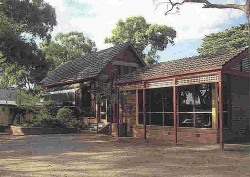
Saint Faith has given her name, not to a church
as such, but to an area to the north of the city of Norwich with
associations with our saint and with her Abbey at Conques, in
southern France, dating back to the early Middle Ages. The village
of Horsham St Faith, and the
adjacent smaller village of Newton
St Faith, bear her name, as does the Norwich City Crematorium (see new
addition at the foot of this item: March 2008) and the airfield nearby.
 Thoughts on a
Pilgrimage
Thoughts on a
PilgrimageSee also
'A Cinderella Church' below for another Norfolk discovery - not
in Great but in Little Witchingham!
Saint Faith in Wales
‘Faith to Faith’
'Our Church is about 45 years old and, like yours, is red brick built. It looks a bit like a health centre! It is a modern-style, dual-purpose building, with a good stage at one end and ‘God’s end’, which is full of Frank Roper metalwork and unusual coloured glass [large chunks set into the east wall, as opposed to a stained glass window] at the other.
St. Faith’s,
Llanishen, is the daughter church of the parish; the main church
is a centuries-old stone building in excellent repair and
dedicated to the Welsh saint, Isan. For many years St. Faith’s
has been the poor relation, with little money or care spent on
it, except that its congregation love it. But I love St. Faith’s
too, and during the recent interregnum, which lasted nearly a
year, and now with the added bonus of encouragement from my new
Vicar, I have been encouraging the people to ‘see what we can do
about our church’ We have already raised over £5,000 pounds and
bought new chairs, done some decorating, increased our
congregation and better served the local community and social
projects in Cardiff.
2005: Gillian later moved elsewhere in South Wales, and has
retired from full-time ministry, but we remain in contact with
her and with 'her' Saint Faith's.
2008: A link to Gillian's
photographs of the tiny St Faith's Church at Welsh Newton
Common, Hereford, appears below or can be accessed HERE
More news from St Faith's, Llanishen
in 2008
Gillian has provided us with a
selection of photos, taken by her son, of her previous parish.
the one below shows the church banner in the sanctuary at
Llanishen.
Follow this link for a separate page of words and pictures, uploaded on
January 30th, 2008.
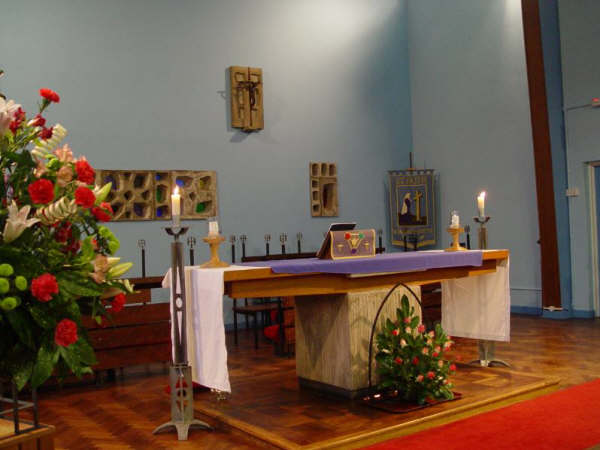
One of the more unusual churches dedicated to
our patron saint was the chapel of Stanley Royd Hospital in
Wakefield, which previously rejoiced in the name of the West
Riding Pauper Lunatic Asylum: the name inscribed on the church
silver. It has been closed for some years now, and abandoned, but
it was, according to a history of the institution, a place of
refuge and peace, big, but never frightening or impersonal.
Patients came down there from the
wards, into a church with two lofty naves and no transepts. The
organ was at the end of one nave and at the other a magnificent
stained-glass window, picturing members of various hospital
professions with patients. Beneath it, a real patient had
painted an unforgettable Last Supper, with the thirteen figures
all bearing the same haunted face.
Social
segregation was built into the architecture of this St Faith’s.
The arches separating the twin naves strictly separated male
patients and staff from female ones. In later years, all this
changed, and the far smaller congregation used only part of one
nave. But to the end, as the chaplain relates, ‘the church never
changed, so that all the time, at every service, I was conscious
of the special role of this particular church – to be a focal
point for the hospital’s purpose of caring and healing. It is
abandoned now. Then it was the heart of the asylum.'
(With thanks to the Revd Roger
Grainger and Mrs Angela Capper for information)
Thanks to a contact from local resident Mark Davies, who specialises
in recording some of the fading glories of the past in his area,
we can now link to a gallery of his evocative photographs (two of
which appear below) of the closed and decaying church, as well as
many images of the whole complex which it served. The
Asylum/Hospital is a magnificent piece of Victorian architecture,
ornate and spacious and highly decorated, and it is sad to see it
unused and at risk from vandals.
Mark's pictures, with accompanying text, may
be seen by following THIS LINK within our site. Featured
are the fine east window, and atmospheric pcitures of the decay of
this fine church.
Follow THIS LINK for Mark's original
'silverstealth' webpage, featuring the pictures and text
reproduced from our feature above.
By clicking
on THIS LINK
you can explore the rest of the building; from there the gallery
links supplied access further pages about the origins, history and
present state of this fine building, haunted by memories of its
past.
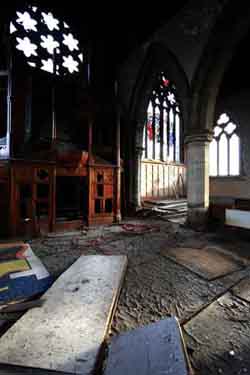 .
.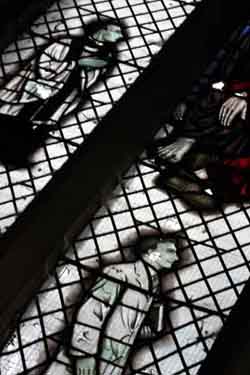
(February 3rd - 5th, 2008)
Another Australian Saint Faith's
Ian Gibson writes about Saint Faith's, Burwood, near
Melbourne
The parish was established at the end of the 19th century. At the
time the church was in an orcharding area, and for many years it
was at the terminus of a tramline that went into central
Melbourne. The suburb really took off in the baby and building
boom immediately after WWII, and that really marked the transition
to a fully fledged suburban parish.
The church is unusual. The nave is circular, with a sanctuary incorporated in an extended elongation of the nave and a chapel and (once baptistry, now oratory) at the north and south sides of the nave. It was an important new architectural direction when the church was built in 1957: this was still a decade before Vatican 2!
Since about 1950 the parish has always had priests in the Catholic (and almost always liberal Catholic) tradition, although at the milder and unfussed end of the spectrum - the parishioners are firmly "middle" church, and there is virtually no liturgical formalism.
We have a collection of reproductions from Conques around the parish premises, but the image that would interest you most is an icon written some 15 years ago by a parishioner in vivid colours. This is now in the oratory.
The parish takes very seriously St Faith's patronage of prisoners, and links this dedication to its support for Amnesty International. (I am personally a current member of the International Executive Committee of AI.)
(added May 31st, 2005)
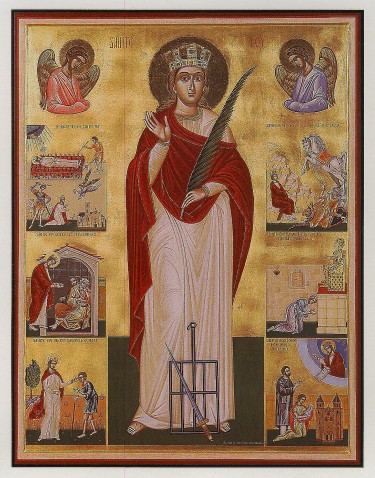
To mark the 1700th anniversary of the martyrdom of Saint Faith, this icon, by Eva Vlavianos, was commissioned at Conques.
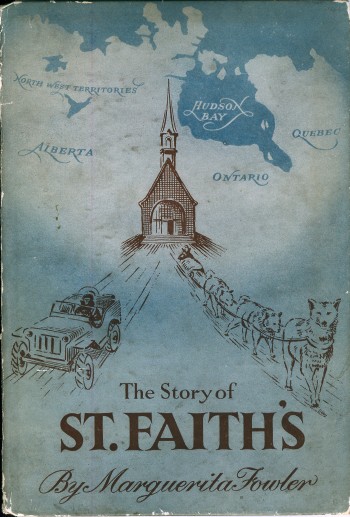
The Bishop's Messengers and St Faith's
A little book, published in 1950 (priced at two shillings!) by The Society for the Propagation of the Gospel in Foreign Parts, supplied to me by Fr Dennis Smith, and whose cover is reproduced above, tells a remarkable story. The St Faith’s of the title is in the Brandon Diocese of the Anglican Church in Canada, and it was there that Miss Marguerita Fowler came from England fairly early in the last century and founded the Canadian ‘Bishop’s Messengers’ to spread the gospel, and establish schools and missions over a very large area. Starting at Swan River Valley, then the northern limit of the main settled area, and a parish itself some 400 miles square, she and her workers extended their influence over the vast areas leading north to Hudson Bay.
The Mother House of this lay order (it seems never to have been monastic as such, although they wore distinctive clothing, created a Rule, recited daily offices and held retreats) became known as a true household of faith. "We called the house St. Faith's because we already had a vision of the work opening in many directions, and we realized we were out on "venture of faith",' Miss Fowler wrote in 1931. She and her helpers worked tirelessly in remote areas, both with white settlers and with the Siioux Indians, and established Sunday Schools and medical facilities.
She retired eventually to England where she died in 1970. An internet search of the current Diocese shows no trace of St Faith’s name, the mother house having been renamed and its purpose changed, although the scattered mission outposts her team helped to set up exist today as staffed Anglican parishes. What also remains is a plaque in Brandon Cathedral, recorded on its website. It reads
To the Glory of God
and in memory of Margeurita (sic) D. Fowler O.B.E.
Founder of Bishop’s Messengers of St Faith’s 1928,
Born 1884 –Died 1970.
It was placed there, according to the Cathedral, ‘on Feb. 26, 1973 in honor of a great pioneer lady whose vision and fervent dedication to a calling has furnished the people of Swan River and surrounding areas with a unique experience in courage, Christian love and charity.’
The little book (apparently quite a rarity) tells the story of this indomitable Anglican lady. She chose our patron’s name for its meaning rather than its story, but her life and work add a very real lustre to the long story of Saint Faith and all those associated with her down the centuries.
(29 August 2005)
The St Faith's Token
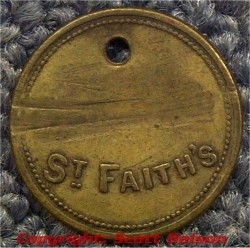
The ubiquitous Google internet search engine throws up some intriguing oddities. The St Faith’s Token, illustrated above, is a rare South African coin, whose origins seem to be obscure, but which is recorded on numismatic websites. Here is what one such site says:
‘Some rare South African tokens
from the Umzimkulu region: St Faith's Token.
The first St Faith's token "discovered" by a numismatist (Scott Balson) – as recorded in Dr Theron's 1980 book on South African tokens. Not much is known about these tokens but there is a Roman Catholic Mission, if you dare cross a real scary old timber bridge over a deep gorge in the St Faith's, Umtentweni, district East of Ixopo. Up to date, three or four St Faith's tokens have been found - the value of this token being about R3750,000 and although this token is rare, it can still be purchased today.’
More than this I have been unable so far to discover, having drawn a blank on Umtentweni and its ‘real scary old timber bridge’. Another website reckons the St Faith’s 6d token to be actually unique, and values it at $3,000. It would be interesting to discover more about the Mission, its connection with our patron and the origin and use of these tokens.
(29 August, 2005)
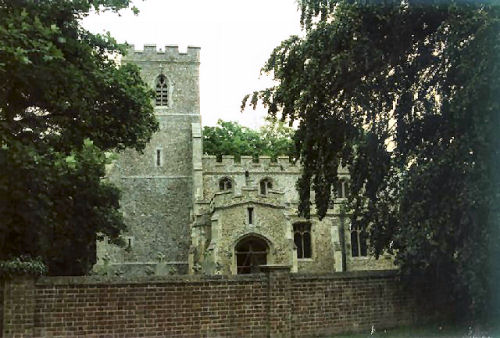

Saint Faith in Pennsylvania
In March, 2007, I received this email, informing us of the
existence of yet another St Faith's church - this time in
Havertown, Pennsylvania; as a result, the church was added to the
'foreign' list below.
'I was rector of Saint Faith parish in the
Blessings and peace,
The Rev. Robert H. Brown'
And at the beginning of April this charming picture, from the same correspondent was emailed to us.
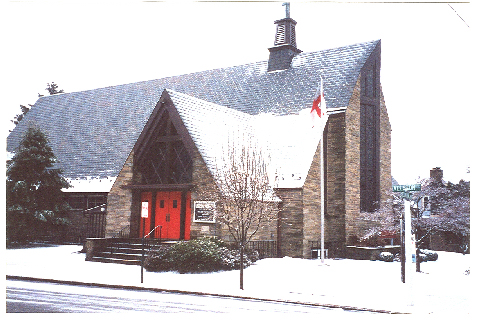
Web search reveals that the current Rector is the Reverend
Patricia A. Oglesby; interestingly all the references in Google
refer to 'Saint Faith Church' rather than sporting the usual
apostrophe.
(feature
added April 2nd, 2007)
St
Faith's for Sale
(added September 7th, 2007: directory list
amended accordingly!)
Peter Stokes (St Faith and St Laurence, Harborne, Birmingham:
see the entry for this church above), supplies this sad sales
pitch from a recent Sunday Times.
IS IT WORTH IT?
St Faith's Church, Belper Lane
End. Derbyshire, £200,000
What it is: St
Faith's is a deconsecrated stone church at Belper Lane End, in
the Derwent valley. It is named after a teenager from southern
France who was martyred in AD304, or thereabouts, for refusing
to make pagan sacrifices. Built in 1890 (for £304) as a chapel
of ease to the larger Christ Church, it was attended by the
nuns of the convent of Saint Laurence, an Anglican order, and
served as a Sunday school. The last service was in 2005: the
Anglican diocese decided to sell because the congregation had
shrunk to just two people. The hamlet is on the outskirts of
Belper, a bustling market town that serves as a gateway to the
Peak District. It is 10 miles from Derby and 25 from
Nottingham. The agent has set a deadline for sealed bids — on
the official form — of noon this Wednesday, September 5.
The problems: The
church is effectively a shell, and the adjoining vicarage has
been turned into a meeting hall. The diocese still owns it,
and the ecclesiastical trappings, including the altar, the
pews and the font, have not been removed. It is described as a
"hot potato" by the selling agent — an attempt to win
residential planning permission has failed on appeal, so a
buyer is taking a big risk if they want to move in anytime
soon. The community has set up a website to save the property.
The advantages: More
than 75 brochures have been sent out since St Faith's was put
on the market in midsummer. "It has created immense interest,"
the agent says, "but without the residential consent, turnout
on viewing days has been low." Approval for residential use
would almost double the asking price.
December
23rd, 2007: Latest news from St Faith’s, Belper Lane End
Jenny Raynor, wife of
a previous curate at St Faith’s, describes a recent visit to
the church
'Belper is a
relatively small town, so we thought there would be no
difficulty in finding St Faith’s Church. Within a few minutes,
we found what was once the Convent of St Lawrence and has
since been converted into trendy (and obviously expensive)
apartments. Across the road was a congregational church and
the parish church of St Peter was just down the road. Local
people had heard of St Faith’s, but no one seemed able to tell
us where it was. Eventually the offices of the local paper
came to our rescue and pointed us in the right direction. Even
so, we stopped at a grocer and newsagent’s shop to check the
directions and it was here that we heard the full tale. The
shopkeeper and her family had been leading lights in the
church for almost a lifetime and had seen numbers fall off. It
was united with Christ Church, Belper at the bottom of the
hill where some of the practices (e.g. the use of incense)
were not considered best suited to St Faith’s (Belper, that
is). In time, a plan was put forward to close St Faith’s and
use the proceeds to fund a youth worker.
There is some debate as to whether the church has actually
been sold, and to what purpose it will be put. While it is
said that there is a covenant that it cannot be converted into
living accommodation, the word on the street is that it might
become a wine bar (though we felt it was too far from the town
centre to be a realistic proposition).
One of the more curious aspects of the building is the
apparent housing tacked on to the east end, which look for all
the world like two houses. As it is so far from the convent
(probably a couple of miles), we wondered whether some of the
sisters lived in the houses and so were able to worship in the
church.
The other interesting fact we picked up is that the ‘church’
is probably more active now than it had been for some years
leading up to its closure. They recently held a well-attended
Harvest service on the field opposite the church and have
plans for other activities, too.'
The Raynors' photographs below show the church, and a poster
giving evidence of the strong local support for the church.
Watch this space – or, if anyone hears more, please let us
know.
=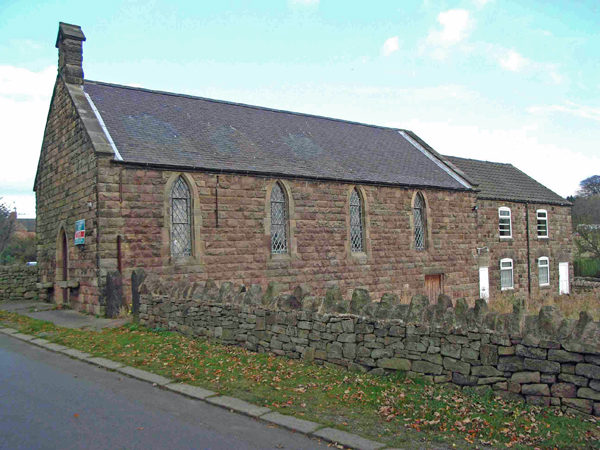
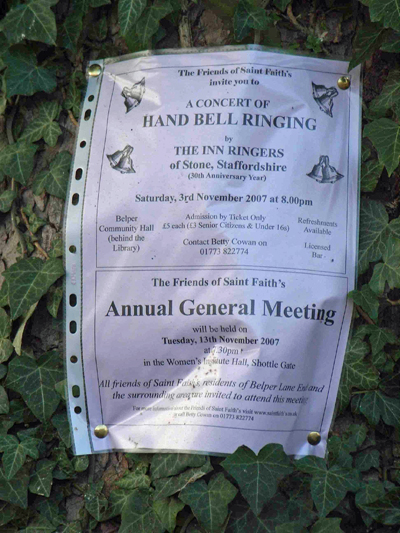
Room at the Inn for
St Faith's!
A
recent feature in the Sunday Telegraph brought to
light a new church dedicated to our patron saint
- at Dunswell, north of Hull. The
church, a daughter church of St John, Newland, was
damaged in the devastating floods to hit the area
last summer. As a result, the congregation have
for some months been worshipping in the Ship Inn
at Dunswell.
The article reproduced below tells the
story. The church has its own website - follow this
link - which will
also give access to other newspaper articles, with
some equally dreadful headlines!
The people of St
Faith's, who will worship in their village hall
and, of course, their local, over Christmas, hoped
to be back in business in their church on January
13th, 2008.
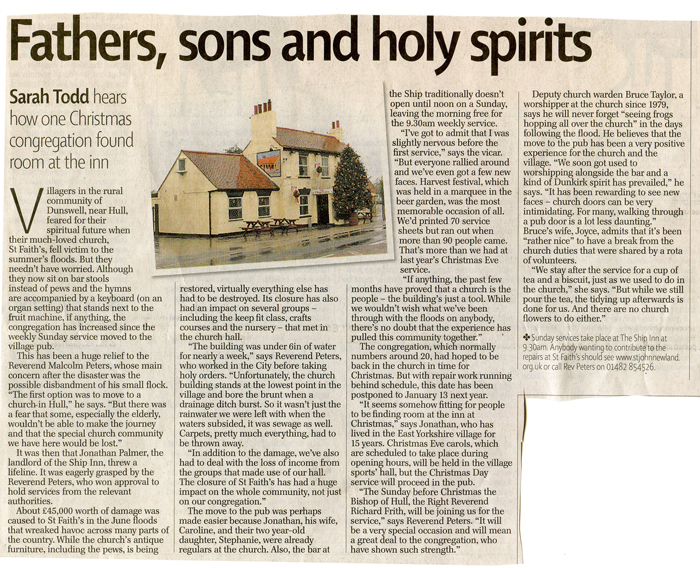
Singing Saint Faith
January 8th, 2008
Thanks to ex-chorister Miriam Jones, we have discovered the existence of a hymn tune bearing the name of our patroness. It was written by George E. Lewis, believed to have been a one-time organist at our church, and is headed 'Hymn Tune and Double Chant'. The words of the well-known hymn, praying for peace and protection at night time, are by John Keble (17982-1866), founder of the Oxford college which bears his name. We await further enlightenment about Mr Lewis, and look foward to a 21st century revival of the opus, perhaps at a future Evensong!
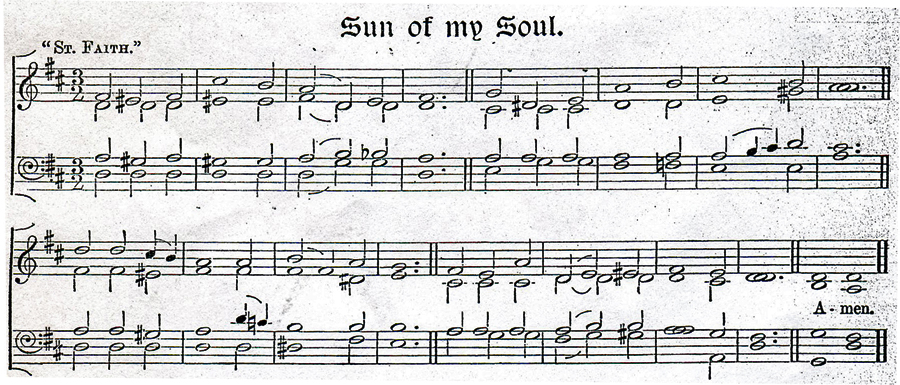
Saint Faith's in retirement in East
Yorkshire!
January 12th,
2008
A church dedicated to Saint Faith existed
in the village of Leven, in the East Riding of Yorkshire, until
its demolition in 1844. Information gathered from various websites
tell us that this medieval church stood one and a quarter miles
from the middle of the present village. The church, in use from
1350 to 1843, was probably preceded by an earlier wooden church of
the same name. Although the church itself is no longer standing,
the old graveyard is still there with tombstones which are still
readable. The present Holy Trinity church in Leven was consecrated
in 1845 on a site on the main road and beside an already
established village. A pilgrimage is made each year by villagers
from Holy Trinity to St Faith's where a short service is held. The
old St Faith’s Rectory, sited on the Beverley road on the
outskirts of the village, is now known as Abbeyfield House, a
residential home for senior citizens. A settlement of flats and
bungalows houses about 20 senior citizens, with a resident warden.
The late, Mrs Kathleen Vickers, the mother of Mrs Angela Capper,
wife of Fr Richard Capper, one time vicar of our St Faith’s in
Great Crosby was a residen there up to the time of her death.
Further research reveals that there was a medieval fair held in
Leven on St Faith’s Day, presumably then as now October 6th. The
church, seemingly made of brick and boulders, is reported to have
been in disrepair during the 16th and 17th century, and was
largely demolished in 1844. It appears that the chancel remained
for a time for funerals until the closing of the churchyard in
1876 and the demolition of the remaining part of the building in
1883.
The ‘new’ church in the village, contains part of a 9th century
cross shaft, a late 13th-century font and the head of a
15th-century cross from the old St. Faith’s churchyard., as shown
below. Finally, a separate source records the probable existence
of a medieval holy well, now buried, in the vicinity of the old
church.
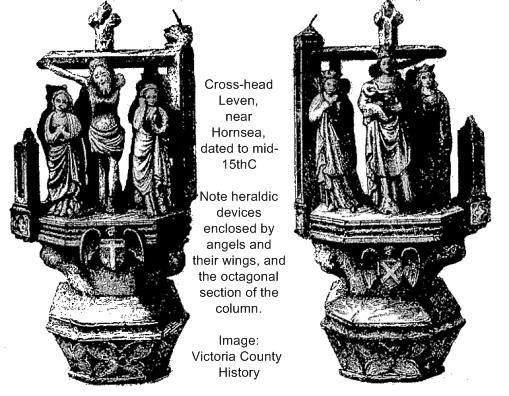
Saint Faith's for the Future
Under the headline 'Makeovers breathe new life into village churches', the Daily Telegraph for March 22nd, 2008, featured rural churches which, faced with dwindling populations and congregations, are finding ways of surviving and diversifying.
Among them is our namesake church in the little village of
Hexton, in Hertfordshire, about which the article simply says that
they have 'built a kitchen and laid a new wooden floor, allowing
the nave area to be used by playgroups, youth clubs and the local
primary school. It has also hosted fashion shows, concerts and a
farmers' market.' The article was accompanied by the photograph
below.
Google search however reveals that they also have a website,
which explains more about the perilous state from which the
building has been rescued and its imaginative use. Part of its
home page reads:
'St Faith's building has a fine East Window by Harry Stammers, two Georgian pulpits, and an 1820 organ. In 1947 two sides of the tower collapsed. In 1961 thieves stripped the lead off the roof. The nave deteriorated into a damp and seldom used space, though regular worship continued in the chancel. A restoration project began in 1994. In 2000 the whole village decided to refurbish the nave as both a church and a community centre. This was completed in 2006. Now the nave, known as St. Faith’s Community Centre, is in daily use by groups, the playgroup, the school (which has no hall) youth club and WI. St. Faith’s was among the twelve national prize winners for ‘The Best Church Building for the Future, 2005’.
It is great to hear of this success story, and we wish St Faith's, Hexton, every blessing for the future. Visit their website for more words and pictures.
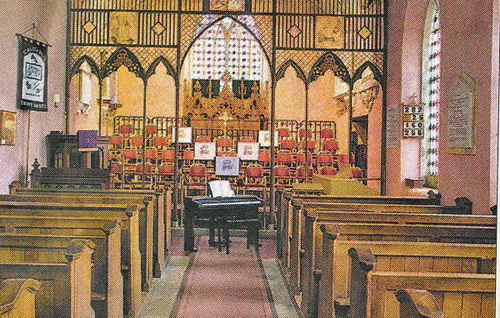
Feature added March 26th, 2008.
Saint Faith's with a Tin Roof! |
The little Church of St Faith, Welsh Newton Common, in the
Diocese of Hereford and close to the Welsh border, is likely to be
the smallest of the churches dedicated to our patron.
Thanks to the Reverend Gillian George-Rogers, now of Monmouth but
once of St Faith's, Llanishen (one of only two only known Welsh
dedications), we can add a page of words and pictures -
follow THIS LINK to see the
building inside and out and to learn that small can certainly be
beautiful! (online May 13th, 2008)
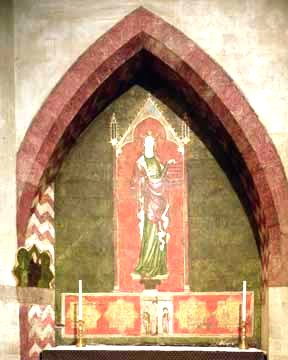 |
Saint Faith in Westminster Abbey |
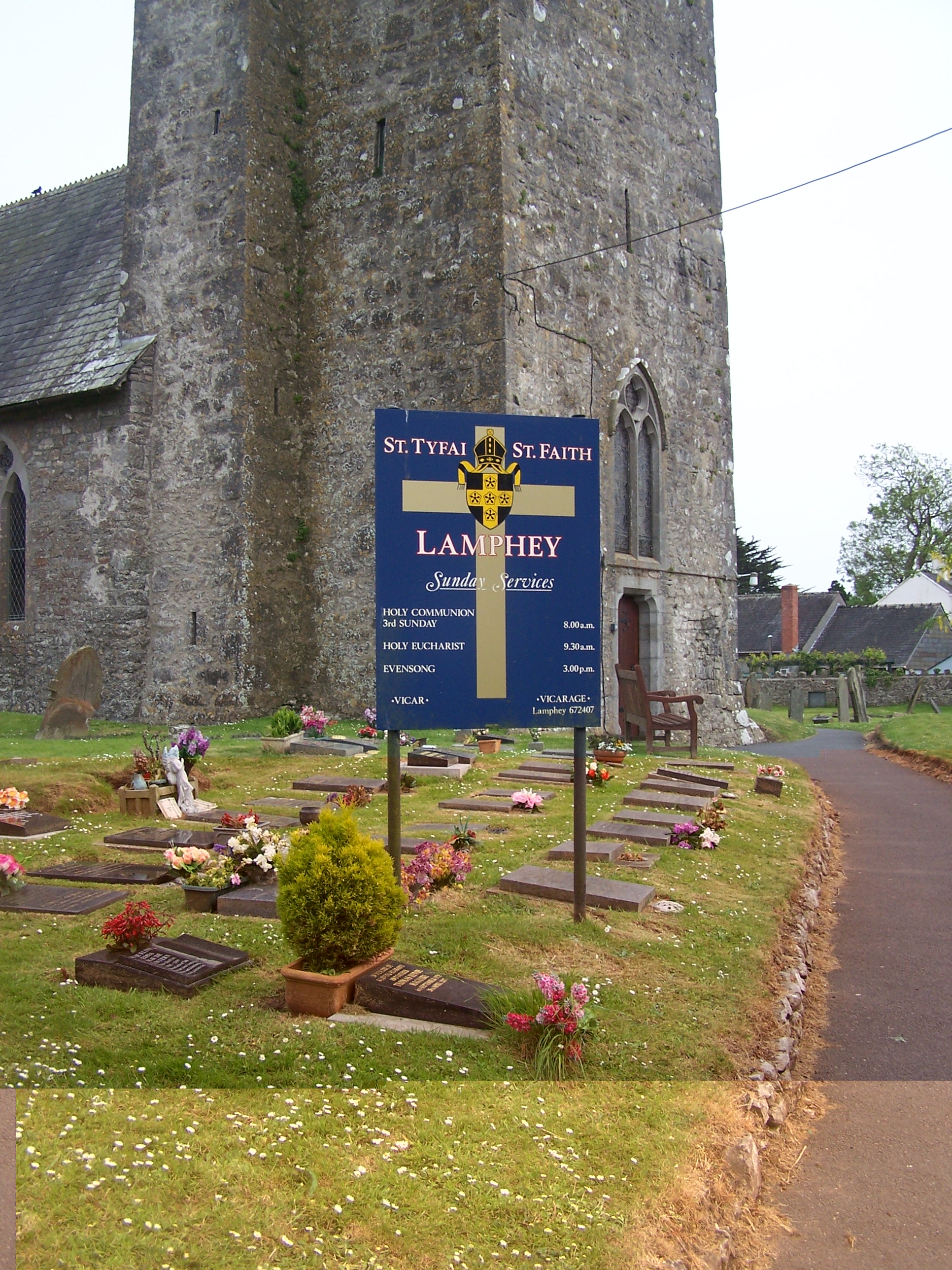 |
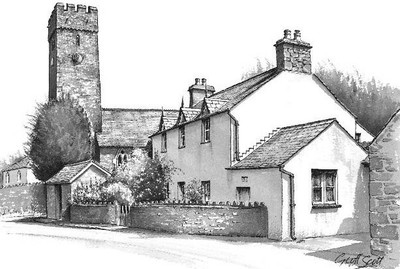 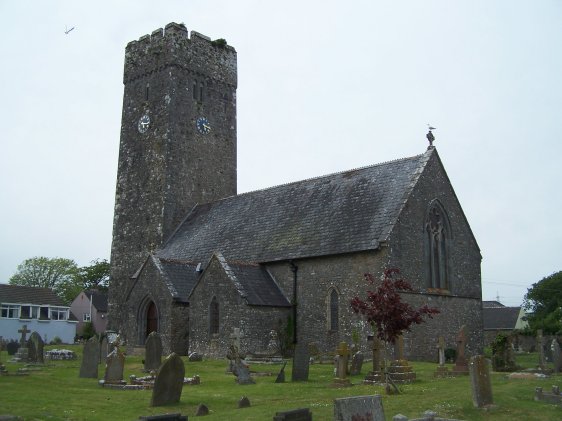 |
|
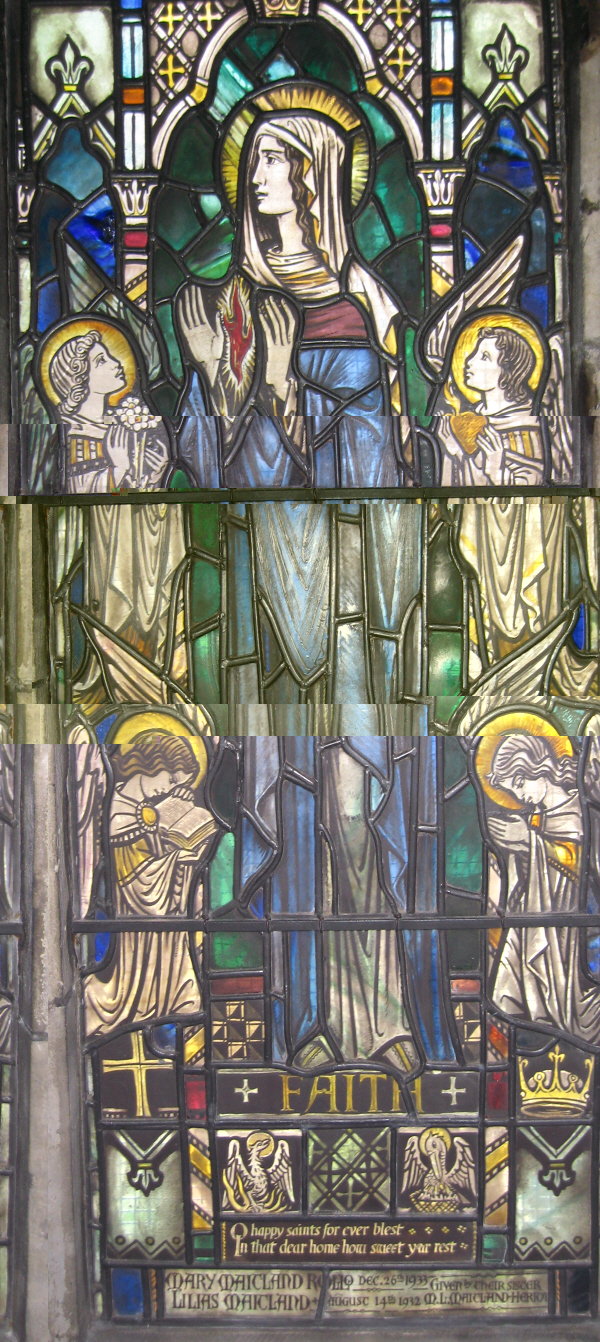 |
Thanks to Peter Stokes, of the church of St Faith and St Laurence, Harborne, Birmingham, we have been sent this photograph of a fine stained glass window in the south aisle of the Scottish Episcopalian church of All Saints, St Andrews. The designer was Herbert Hendrie, who was a leading designer of stained glass in the early 20th century, and who also designed stained glass for Liverpool's Anglican Cathedral. The church guide book, states that it was presented by a Mrs Maitland Heriot in memory of her two sisters Mary and Lilias, but has no mention of why she chose St. Faith. It dates from 1933 or shortly afterwards. It is interesting and challenging to see that the dedication is to 'Faith' rather than to 'our' saint. It's possible that the figure represents the abstract figure of Faith as a charity (cf Hope, Love) rather than the saint herself, but there are no other windows there to prove or disprove this. The legend below reads 'O happy saints for ever blest/In that dear home how sweet your rest' - which may point in our direction, or simply refer to the dedicatees of the window. The figure's hands shelter what looks like a flame, perhaps of martyrdom, and the surrounding and supporting figures and ornamentation have a wealth of symbolism, including the self-sacrificing pelican of Corpus Christi, a crown (martyrdom again?), what looks like a phoenix rising from the flames (likewise martyrdom?), white (virginal?) flowers and a heart seemingly on fire. Experts in saintly symbolism may be able to clarify the further significance of these symbols; meanwhile it is we trust acceptable to associate this intriguing window with St Faith, in what would be her most northerly British outpost. Visit the All Saints website on http://www.allsaints-standrews.rog.uk Added October 6th, 2011, the Feast of Saint Faith, Virgin and Martyr |
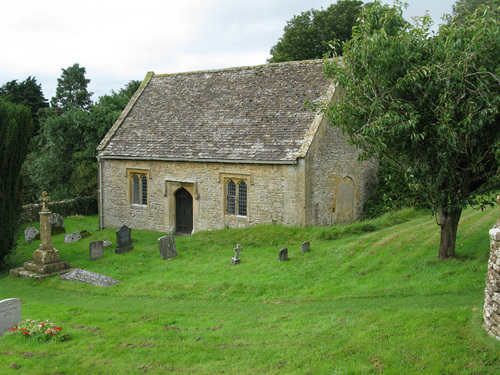 |
St Faith's is described as a Chapel of Ease, long attached to St Michael's church, Guiting Power some five miles away to the north-west. However Guiting Power did have an earlier 11th century Saxon church (revealed in 1990s excavations) near by the present church which could account for the origin of the connection between Guiting Power and Farmcote. FARMCOTE, originally, FERNECOTE, is derived from FERN ,and COED, meaning a wood. The Domesday Book states that the manor was held by a Norman overlord Goizenboded, and the hamlet of Fernecote was attached to Guiting Power. The Chapel of Ease, dedicated to St Faith, is possibly a Saxon, certainly an early Norman building near to 1000 years old. The beautiful timbers of the roof are those placed by the Norman builders. Entrance is by the south door which is late Perpendicular, with spandrels bearing the Tudor Rose, and on the pillar on the left can just be seen a Mass Dial. The church now consists of a Norman nave only, for the east end is now a flat wall showing only the Chancel arch with its curious leaning pillars and round-headed arch, which is possibly Saxon, or of 11th century date. Foundations were examined in 1891 and that showed that there had been a small, semi-circular chancel. The north wall has a good Early English lancet window with external mouldings and hood-mould, and there is a two-light Perpendicular window at the west end. There is a Norman font and also a small early Norman double bellcote. Furnishings: we note the 17th century Communion rails (with Victorian restoration), the pulpit with its sounding board and the clerk's desk, all of the same date. The Communion table has a thirteenth century stone mensa with the consecration crosses at each corner and in the centre. This stone would have been removed at the Reformation and was replaced on this 17th century oak frame or table in the 1891 restoration. To the left of the altar is a fine canopied tomb with the recumbent figures of Henry and Mary Stratford. The figures are wearing Elizabethan dress of about 1590 date. The Stratford family, who owned at various times the Manor Farmcote from 1320, produced some noted men: John Stratford was Lord Regent of England during the reign of Edward II. He was appointed Archbishop of Canterbury in 1333 and also became Lord Chancellor and Lord High Treasurer. He died in 1348 and his body lies in Canterbury Cathedral. His brother Robert Stratford was Bishop of Chichester. On his death in 1362 he was interred in Chichester Cathedral. Ralph Stratford, who died in 1354, was Bishop of London and was buried in Westminster Abbey. In the churchyard is the tombstone of the Reverend George Brereton Sharpe, who effected the restoration of Guiting Power Church of St Michael and was Vicar here 1900-1915. Turning right from the churchyard and continuing down the lane, the old Manor House of the Stratford family is seen. It was restored during the 19th century but retains some earlier features, notably the 17th century doorway with the Stratford coat of arms above. From Farmcote one can look over Bredon, the plain of Avon and Severn to the Malvern Hills, and beyond them into Herefordshire, even to Wales. Turning left out of the churchyard, a walk down the rough track will bring you to Hailes Abbey, and yet another walk over the fields along the Cotswold Way will take you to Beckbury Camp near Coscombe, an Anglo-Saxon encampment. |